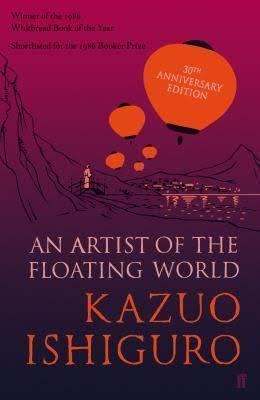7.4 /10 1 Votes7.4
Language English Pages 206 pp OCLC 52638142 Publisher Faber and Faber Awards Costa Book of the Year | 3.7/5 Goodreads Publication date 1986 ISBN 0-571-20913-0 Originally published 1986 Genre Historical drama Country United Kingdom | |||||||||||||||||||||||||||||||||
 | ||||||||||||||||||||||||||||||||||
Media type Print (Hardcover, Paperback) Similar Kazuo Ishiguro books, Costa Book of the Year winners, Fiction books | ||||||||||||||||||||||||||||||||||
An Artist of the Floating World (1986) is a novel by Kazuo Ishiguro. It is set in post-World War II Japan and is narrated by Masuji Ono, an ageing painter, who looks back on his life and how he has lived it. He notices how his once great reputation has faltered since the war and how attitudes towards him and his paintings have changed. The chief conflict deals with Ono's need to accept responsibility for his past actions. The novel also deals with the role of people in a rapidly changing environment.
Contents
Narrative structure
In the buildup to World War II, Ono, a promising artist, had broken away from the teaching of his master, whose artistic aim was to reach an aesthetic ideal, and had gotten involved in far-right politics, making propagandistic art. As a member of the Cultural Committee of the Interior Department and official adviser to the Committee of Unpatriotic Activities, Ono had become a police informer, taking an active part in an ideological witch hunt. After the 1945 defeat and the collapse of jingoistic Imperial Japan, Ono has become a discredited figure, one of the "traitors" who "led the country astray"; meanwhile, the victims of state repression, including people Ono himself had denounced, are reinstated and allowed to lead a normal life. Over the course of the first three sections, spanning October 1948 – November 1949, Ono seems to show a growing acknowledgement of his past "errors", although this acknowledgement is never explicitly stated. However, in the short fourth and last section (June 1950), Ono appears to have returned to his earlier inability to change his viewpoint.
The book is written in the first person and hinges on the exclusive use of a single, unreliable narrator, expressing a viewpoint which the reader identifies as limited and fallible, without any other voice or point of view acting as a test. Ono often makes it clear that he is not sure of the accuracy of his narrative, but this may either make the reader cautious or, on the contrary, suggest that Ono is very honest and, therefore, trustworthy.
The self-image Ono expresses in his narrative is vastly different from the image of him the reader builds from reading the same narrative. Ono often quotes others as expressing admiration and indebtedness to him. Ono's narrative is characterised by denial, so that his interests and his hierarchy of values are at odds with the reader's. Readers, therefore, find that what they are interested in is not the focus of Ono's narrative but at its fringes, presented in an oblique rather than direct fashion. For example, Ono's descriptions of his pictures focus on pictorial technique, mentioning the subjects as if they were unimportant, although they reveal the propagandistic nature of his work. It is not entirely clear whether this focus on style rather than substance should be ascribed to Ono as narrator (showing his retrospective, unconscious embarrassment), or if it was already present in him at the time he was making the pictures (showing that totalitarianism exploits people's capacity to restrain their awareness to limited aspects of their actions). Similarly, when Ono narrates an episode in which he was confronted with the results of his activities as a police informer, it is debatable whether his attempt to mitigate the brutality of the police is a retrospective fabrication devised to avoid his own responsibility, or whether he actually did disapprove of the treatment of the person he had denounced, distancing himself from his actions and refusing to recognise the abusive treatment as a direct and foreseeable consequence of those actions.
Themes
Among the themes explored in this novel are arranged marriage, the changing roles of women, and the declining status of "elders" in Japanese society since 1945. The novel is narrated by a man who, besides being an artist, is also a father, a grandfather, and a widower. It tells, with a strong voice, much about the "pleasure era" of Japanese society, elaborating on the life of a successful and devoted young artist in a decadent era. We learn how attitudes toward Japanese art and society became less tolerant of such extravagance, and what it was like to live with the guilt of such pleasure. The pace is slow and lingers over details, reflecting the central theme.
Awards
The novel was shortlisted for the 1986 Booker Prize and won the Whitbread Book of the Year Award for the same year.
Title
The novel's title is based on the literal translation of Ukiyo-e, a word referring to the Japanese art of prints. Therefore, it can be read as "a printmaker" or "an artist living in a changing world," given both Ono's limited understanding and the dramatic changes his world, Japan in the first half of the twentieth century, has undergone in his lifetime.
The title also refers to an artistic genre. Ono's master was especially interested in depicting scenes from the pleasure district adjacent to the villa in which he and his students lived. Ono mentions the ephemeral nature of the floating world that could be experienced during each night. His master experimented with innovative softer Western-style painting techniques. Ono became estranged from him and forged his own career. He could not help but feel gleeful when his master's paintings fell into disfavour during a return to the use of more traditional bold lines in the paintings used for nationalistic posters.
